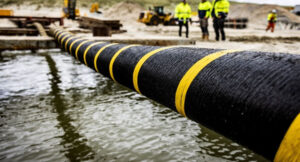Chunghwa Telecom has activated a microwave backup system to maintain communications between Taiwan proper and Lienchiang County (Matsu) after a submarine cable linking the areas was disconnected, the Ministry of Digital Affairs said.
Communications between Taiwan and Matsu are mainly maintained through two submarine cables: Taima No. 2 and Taima No. 3.
Last month, communications were slightly disrupted after Taima No. 3 and part of Taima No. 2 were disconnected due to natural deterioration.
However, the nation’s largest telecom on Sunday informed the National Communications and Cyber Security Center that Taima No. 2, installed off New Taipei City, was completely disconnected, the ministry said, adding that the cause of the disconnection had yet to be determined.
The telecom has also notified the Coast Guard Administration and requested its assistance in its investigation into whether the submarine cable was deliberately disconnected, it said.
Chunghwa Telecom has been asked to activate its microwave backup system, through which voice and data communications between Taiwan and Matsu can be maintained, it said.
The microwave backup system can transmit data at 12.5 gigabits per second (Gbps), higher than the 9.5Gbps required during peak traffic on weekdays.
The telecom has also told the submarine cable laying ship that has arrived at the Port of Kaohsiung to repair the Taima No. 3 cable to start repairs on Taima No. 2 once the No. 3 line is operational, the ministry said.
Taima No. 3 and Taima No. 2 should be fixed by the end of this month and next month respectively if weather permits, the Chunghwa Telecom said.
Priority access to the microwave backup system would be given to government agencies, banks and hospitals to ensure that Matsu residents can perform daily tasks while submarine cables are being fixed, such as online transactions and cash withdrawals from automated teller machines, the ministry said.
The Ministry of Digital Affairs has subsidized Chunghwa Telecom to build a fourth submarine cable, which is expected to be completed in June next year. Taipei Times

Leave a Reply